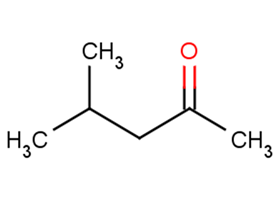
4-Methyl-2-pentanone
CAS No. 108-10-1
4-Methyl-2-pentanone( Methyl isobutyl ketone )
Catalog No. M20232 CAS No. 108-10-1
4-Methyl-2-pentanone is an organic solvent. It is occasionally found as a volatile component of urine. It in urine is considered a biological marker of occupational exposure to this solvent.
Purity : >98% (HPLC)
 COA
COA
 Datasheet
Datasheet
 HNMR
HNMR
 HPLC
HPLC
 MSDS
MSDS
 Handing Instructions
Handing Instructions
| Size | Price / USD | Stock | Quantity |
| 100MG | Get Quote | Get Quote |


|
| 200MG | Get Quote | Get Quote |


|
| 500MG | Get Quote | Get Quote |


|
| 1G | Get Quote | Get Quote |


|
Biological Information
-
Product Name4-Methyl-2-pentanone
-
NoteResearch use only, not for human use.
-
Brief Description4-Methyl-2-pentanone is an organic solvent. It is occasionally found as a volatile component of urine. It in urine is considered a biological marker of occupational exposure to this solvent.
-
Description4-Methyl-2-pentanone is an organic solvent. It is occasionally found as a volatile component of urine. It in urine is considered a biological marker of occupational exposure to this solvent.
-
In Vitro——
-
In Vivo——
-
SynonymsMethyl isobutyl ketone
-
PathwayOthers
-
TargetOther Targets
-
RecptorOthers
-
Research Area——
-
Indication——
Chemical Information
-
CAS Number108-10-1
-
Formula Weight100.16
-
Molecular FormulaC6H12O
-
Purity>98% (HPLC)
-
Solubility——
-
SMILESCC(C)CC(C)=O
-
Chemical Name——
Shipping & Storage Information
-
Storage(-20℃)
-
ShippingWith Ice Pack
-
Stability≥ 2 years
Reference
1.Kawai T et al. Methyl isobutyl ketone and methyl ethyl ketone in urine as biological markers of occupational exposure to these solvents at low levels. Int Arch Occup Environ Health. 2003 Feb;76(1):17-23.
molnova catalog



related products
-
DTP3
DTP3 is a selective MKK7/GADD45β inhibitor, which inhibits cancer-selective NF-κB survival pathway.
-
trans-2-Decenoic aci...
Trans-2-Decenoic acid is an unsaturated fatty acid found in royal jelly produced from the hypopharyngeal and mandibular gland secretions of honeybees.
-
Dodecanal
Dodecanal is a food additive found in Coriandrum sativum L. and is a flavoring agent commonly used in the skin care industry.



 Cart
Cart
 sales@molnova.com
sales@molnova.com


